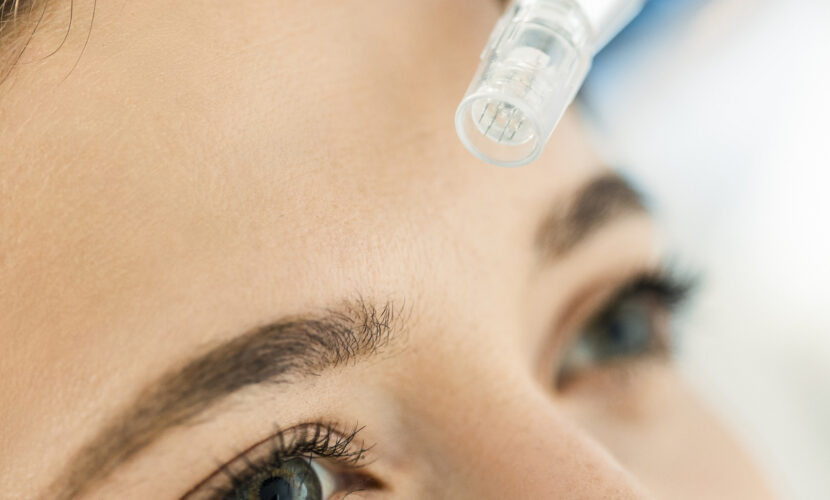Many technologies are gaining attention in the world of cosmetic medicine, but the Dermapen is one of the most controversial. Dermapen is a treatment that helps rejuvenate the skin by stimulating collagen production, but some have said that dermapen should be stopped.
Here, we present basic information about dermapen and its treatment effects, and go deep into the concerns and questions of users behind why such questions are raised. By suggesting how to choose the appropriate cosmetic treatment, we help you make the best choice for your own skin type.

Graduated from the Faculty of Medicine, National Kumamoto University. After serving as the director of major beauty clinics in Japan, etc., he opened Aladdin Aesthetic Clinic in 2023. He is a professional in aesthetic medicine with a doctorate in anti-aging research and many years of experience. With the motto of "Toward the realization of cosmetic medicine without lies," he aims to be the "Only One" together with his patients.
What is a Dermapen? How does it work?

Dermapen is a revolutionary treatment device widely used in the field of cosmetic medicine. This device promotes the skin's natural healing ability by making microscopic holes in the skin using an ultrafine needle.
The "Dermapen 4" with 16 needles is often used for the area to be treated, and this latest model allows the depth of the needles to be freely adjusted up to 3.0 mm, allowing customization according to skin conditions and concerns.
Below is a more detailed look at the dermapen.
Collagen production and skin rejuvenation
The dermapen treatment process begins by creating microscopic holes in the skin. These holes may reach depths from the epidermis to the dermis layer, where the skin's natural repair process is facilitated. The microscopic physical damage inflicted on the skin by the needle stimulates the body's natural defense response and the growth of new skin cells throughout the wound healing process.
Of particular importance in this natural healing process is the production of collagen and elastin. Collagen is the primary structural protein of the skin and is essential for maintaining skin firmness and elasticity. Dermapen treatments stimulate the release of growth factors that stimulate collagen production. This allows the skin to heal from damage and, in the long term, may result in wrinkle reduction and skin tightening.
Elastin is another protein that plays an important role in maintaining skin elasticity. This protein, which is important for skin elasticity, tends to decrease with age, but Dermapen treatment stimulates its production, thereby improving skin flexibility and maintaining a more youthful appearance.
After treatment, the skin begins to self-regenerate and rebuild tissue. During this process, old, damaged protein fibers are replaced with new ones, improving the overall texture of the skin. This regenerative process injects new life into the skin and helps restore a bright, even skin tone.
Improvement effect on acne scars and pores
Acne scars can be reddish, hyperpigmented, and deeply cratered. These are conditions in which inflammation has damaged the dermal layer, resulting in an uneven skin surface. Dermapen treatments act directly on these damaged areas. The finely tuned needles puncture the skin with microscopic holes, reaching deep into the dermal layer and stimulating the production of new collagen there.
This process utilizes the natural skin regeneration mechanisms associated with wound healing. The formation of new collagen gradually lifts the skin's surface, making unevenness less noticeable. This treatment reduces the degree to which cratering acne scars are visible and improves the appearance of smoother skin texture.
Dermapen is equally effective for pore problems. Open or clogged pores can be caused by aging skin, excessive sebum production, or improper skin care. The microscopic pores caused by dermapen treatment act deep within the skin to promote skin turnover and facilitate the natural expulsion of dead skin cells and sebum buildup.
Normalization of skin turnover unclogs pores and reduces their visibility. In addition, the production of new collagen and elastin improves skin elasticity and naturally tightens pores. In this way, Dermapen keeps the skin clean and further improves the appearance of pores.
Effect of introduction of cosmetic ingredients by dermapen
By drilling microscopic holes in the skin, dermapen treatment can deliver cosmetic ingredients directly to deeper layers of the skin that are difficult to reach with the usual top-down approach. This process is called the "drug delivery effect," and it significantly increases the absorption rate of active ingredients by temporarily overcoming the skin's barrier function.
The clinic will select and use the most appropriate introductory solution based on skin type and concerns. For example, an introductory solution rich in hyaluronic acid may be recommended for people with dry skin, while a solution containing a high concentration of vitamin C may be recommended for those concerned about pigmentation. This maximizes the effectiveness of the treatment and contributes directly to the improvement of skin texture.
Number of treatments and intervals between treatments to realize the effects of dermapen

The effectiveness of dermapen treatment depends largely on the number of treatments and the intervals between them. In general, it is difficult to expect immediate noticeable improvement after the first treatment, and skin conditions gradually improve over the course of multiple treatments. An effective treatment plan usually recommends that the first three to four treatments be spaced four to six weeks apart. This time frame is based on the skin's natural healing process and collagen production cycle, and the best results are achieved with consecutive treatments.
The specific number of treatments required to realize the benefits of treatment varies from person to person, but in most cases, clear improvement can be seen after four to six treatments. After treatment, one can expect to see an improvement in skin texture, tone, and elasticity, as well as a reduction in the appearance of wrinkles and pores.
Skin changes during the treatment period
After undergoing a dermapen treatment, the skin may experience mild redness and swelling for the first few days. This is a normal reaction and usually resolves spontaneously within a few days. After treatment, the skin will gradually show its benefits as it stimulates the production of new collagen and elastin. During this process, the skin will feel smoother and tighter, and a more youthful appearance can be expected.
Long-term maintenance
Regular maintenance is essential to maintain the effectiveness of dermapen treatment. After the initial treatment phase is completed, treatments are generally scheduled every 3 to 6 months. This allows for a sustained improvement in skin condition and a long-lasting, youthful appearance.
Maintaining an appropriate skin care routine in daily life is also important to maximize the effects of treatment. Adequate moisturizing, proper sunscreen use, a balanced diet, and adequate water intake are recommended to maintain beautiful skin.
Dermapen treatment is a powerful tool that, with proper planning and ongoing care, can provide long-term skin beautification. Establishing the best treatment plan for your skin through regular consultations with a specialist is the key to maintaining healthy and beautiful skin.
Understanding the Risks and Side Effects of Dermapen

While dermapen treatment is an effective procedure that is widely recognized in the cosmetic industry, it does have some side effects. The fine needles used during the treatment puncture the skin, which can cause a temporary inflammatory reaction. This reaction results in the redness and swelling seen immediately after treatment. These symptoms usually subside spontaneously within a few days, but may last a little longer in those with sensitive skin.
Internal bleeding may also occur if the needle comes in contact with minute blood vessels in the skin. This condition usually appears as purple or blue-black spots and resolves spontaneously in about a week, but may be slightly bothersome if noticeable.
Peeling may occur as the treatment accelerates the skin's regenerative process. This is one of the effects of the treatment, a process by which dead skin is shed to reveal new, healthy skin. This natural turnover is important for improving skin quality.
How to care for skin after treatment
After treatment, the skin is especially delicate and requires proper aftercare. Moisturizing is extremely important, and moisturizing creams and serums should be actively used to prevent dryness. It is also essential to apply sunscreen, as post-treatment skin is very sensitive to UV rays, and it is recommended to choose products with a high SPF value and reapply frequently when going outside.
In addition, temperature control is also important. To avoid irritating the skin immediately after treatment, avoid using hot showers or saunas, and try to wash your face with warm water that is gentle on the skin. This will minimize the stress on the skin.
How to deal with side effects
If side effects occur, cooling pads can be used to alleviate redness and swelling. It is also important to treat the skin gently after treatment and avoid excessive friction. This care prevents additional irritation to the skin.
Additionally, it is important to follow up with your physician if symptoms persist longer than expected or if there are signs of infection. Contacting the clinic where you were treated and seeking appropriate advice and additional care can help to resolve the problem as soon as possible.
Who should avoid dermapen? Appropriate cases and precautions!

Dermapen is an effective treatment for many skin problems, but may not be recommended for people with certain conditions. Below is a detailed discussion of skin types and conditions that should be avoided with dermapen treatment, as well as related precautions.
Skin types and conditions that should avoid dermapen treatment
| situation | Description. |
|---|---|
| Skin with active inflammation | Avoid treatment in cases of severe acne, dermatitis, open wounds or active infection |
| People who have difficulty securing downtime. | Avoid treatment if you cannot secure the care you need during downtime, such as redness and swelling |
| People who expect immediate results | Multiple sessions are required and it is inappropriate to expect significant results from a single treatment |
| Pregnant and lactating women | Avoid treatment because hormonal fluctuations make the skin more sensitive and increase the risk of unexpected reactions |
| keloid constitution | If you have a history of raised scars, treatment may worsen keloids. |
| metal allergy | Needles are made of metal, so people with metal allergies may have a reaction and need to be careful |
Dermapen is an effective treatment for a variety of skin problems, but it is not suitable for everyone. The following description organizes specific skin types and conditions that should be avoided with dermapen treatment.
Skin with active inflammation, e.g., severe acne or dermatitis, may be exacerbated by treatment. You should not undergo dermapen treatment, especially if you have open wounds or an active infection. In addition, there will be some downtime after treatment, including redness and swelling of the skin. If you are unable to ensure necessary rest and care during this downtime, it is difficult to benefit from the treatment and therefore the procedure is not recommended.
Those who expect immediate results are also not suited for dermapen treatment. Because the effects of this treatment are gradual through multiple sessions, it is not realistic to expect noticeable improvement in a single treatment. Pregnant and lactating women are also safe to avoid dermapen because their skin is more sensitive due to hormonal changes, which can cause unexpected skin reactions. People with keloidal conditions or metal allergies may likewise experience problems due to the effects of dermapen needles on the skin.
If any of these circumstances apply to you, it is important to consult with a professional physician before undergoing dermapen treatment to select the approach most appropriate for your own skin condition and health.
Considerations before undergoing dermapen treatment
If you are considering dermapen treatment, advance preparation is critical to maximize its benefits and minimize its risks.
It is important to first have a detailed consultation with a medical specialist regarding your health and skin condition. The physician will determine the appropriateness of dermapen treatment based on a detailed understanding of your skin type, previous treatments, and any current skin problems or conditions you may have. This allows them to know in advance if the treatment is safe and effective.
It is also essential to share a history of past skin diseases. Especially if there are potentially recurring conditions such as atopic dermatitis or herpes, it is necessary to evaluate with the physician how these may affect dermapen treatment. An accurate diagnosis of whether past skin diseases are active or treatable will allow for appropriate treatment planning.
What are the alternatives to dermapen treatment? Summary of cosmetic treatment and approach options!

The cosmetic benefits offered by dermapens are attractive, but as mentioned above, they may not be the right treatment for everyone in some situations. Here we introduce various cosmetic treatments that can be considered as alternatives to dermapen and compare their features with those of dermapen.
Milan RePeel" effective for collagen production
Milan RePeel is a complex peeling treatment containing five different acids (TCA, AHA, BHA, PHA, and citric acid). While these acids provide a peeling effect on the skin, the amino acids and vitamins directly stimulate skin cells to promote the production of type III collagen and help produce elastin and hyaluronic acid.
Compared to dermapen, Milano RePeel can improve the superficial skin as well as bring firmness and luster to the skin. It is also available for the face as well as for the body, addressing a wider range of skin problems.
A very popular and effective option for wrinkle improvement! Hyaluronic acid, Botox, and thread lift.
Hyaluronic acid injections, Botox injections, and thread lifts are effective in improving wrinkles. Unlike dermapen, these treatments are immediate and act directly on specific wrinkles and sagging skin.
Hyaluronic acid injections provide moisture and volume to the skin, while Botox temporarily restricts muscle movement to prevent wrinkle formation. Thread lift is a procedure in which threads are implanted under the skin to lift and lift the skin.
Lumecca" suitable for improving spots and dullness
Lumecca is a new light therapy technology (IPL) that is highly effective against dark spots, dullness, and freckles. The action of light and heat stimulates the regeneration of collagen and elastin, bringing firmness and hydration to the skin and accelerating turnover. Compared to Dermapen, Lumecca can address a wider range of pigmentary abnormalities and can rejuvenate the entire skin.
Sylpharm X" for improvement of acne scars and craters
Silpharm X uses the latest microneedle RF (radiofrequency) technology and is particularly effective for pores, dark spots, and acne scars. It improves skin texture by directly applying heat to the dermal layer of the skin while puncturing the skin with microneedles.
Compared to dermapen, Silpharm X differs in that it is particularly effective for melasma and redness of the face. The treatment also offers excellent texture improvement and is expected to improve the overall appearance of uneven skin tone and dullness.
summary
While dermapen treatment is highly effective, it is not suitable for everyone, depending on the condition. Careful consideration is required, especially for those who are allergic or have had skin diseases in the past. Here we have detailed the risks and side effects of dermapen therapy, as well as cases in which it is not indicated.
We also provide information on alternative treatments other than the Dermapen to help you make the best choice for your situation. Ultimately, it is important to develop a treatment plan that is appropriate for your individual situation through consultation with a specialist. If you need further information or advice, we encourage you to consult with a trusted professional.
At Aladdin Aesthetic Clinic, based on our many years of experience in cosmetic medicine and cosmetic dermatology and the knowledge of our doctoral degree, we provide counseling that aims to be "only one", offering the best treatment for each person we meet. We offer only the necessary treatments without any unnecessary information or suggestions.
Feel free to use our official LINE account for 24-hour counseling and reservations. Please feel free to contact us for free counseling for the first time or if you have any concerns.






